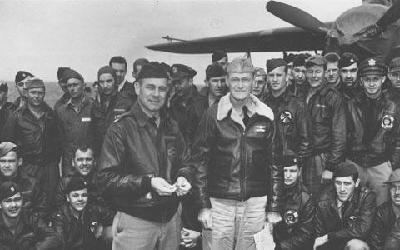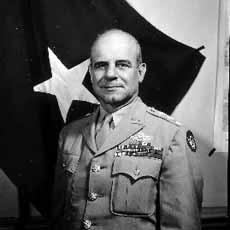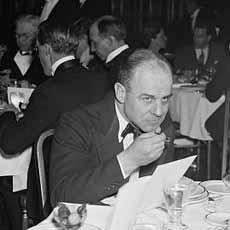
RAY FREEMAN: EXPLORATIONS, a program in Special English on the Voice of America. Today Shirley Griffith and Frank Oliver tell about a famous World War Two pilot, Jimmy Doolittle.
(MUSIC)
FRANK OLIVER: He was a scientist, an airplane engineer and a general in the United States Army.
At one time, he held the record for flying faster than any other person. He was the first pilot to cross the United States in less than 24 hours. He was the first pilot to fly "blind," that is, using only instruments to guide his airplane.
And, when his country entered World War Two, he led one of the first successful attacks against the enemy.
SHIRLEY GRIFFITH: His name was James Harold Doolittle. But to the many thousands of Americans, he was Jimmy -- Jimmy Doolittle.
Jimmy Doolittle was born on December 14th, 1896, in the western state of California. His family soon moved to Nome, Alaska. Jimmy was a small boy. He never grew to be very big. Yet larger boys made a mistake if they thought being small also meant being weak. Jimmy would fight if someone tried to hurt him. And he almost never lost.
FRANK OLIVER: As a young man he became a boxing champion. He held the American West Coast championship for his weight. He continued to box when he entered the University of California to study mineral engineering. He held both the lightweight and middleweight college boxing championships.
(MUSIC)
SHIRLEY GRIFFITH: When the United States entered World War One, young Jimmy Doolittle joined the Army. He also asked to be trained as a pilot. On March 18th, 1918, Jimmy passed the tests and graduated from flight school. He had hoped to go to France and fight in the war. The army, however, had him train other pilots. When the war ended, Jimmy chose to stay in the army. He thought this would give him a chance to combine his flying skills and his interest in engineering.

FRANK OLIVER: For most of the years between World War One and World War Two, Jimmy Doolittle was involved in the growth of the airplane industry. He helped test new airplanes. He flew longer and longer distances. He also entered the world-famous air races of the time. During the 1920s and 1930s, airplane races were used to test new aircraft designs.
Jimmy Doolittle won three of the most important races, the Schneider Marine Cup, the Bendix Trophy race and the Thompson Trophy race. By now, most Americans knew the name Jimmy Doolittle.
SHIRLEY GRIFFITH: Perhaps Jimmy's most important work during this period involved instrument flying. In the early years of aviation it was almost impossible to fly in bad weather. Many pilots crashed in poor conditions because they became lost. In a heavy fog, they could not tell if they were going right, left, up or down. Many pilots and aviation experts said the problem could not be solved. They said it was impossible to fly in bad weather.
Jimmy Doolittle began working with experts who made flight instruments. These instruments helped tell if the aircraft was going up, going down or turning. The instruments helped a pilot fly straight. Other instruments linked radios to a direction device to help find the landing area.
FRANK OLIVER: After ten months of tests, Jimmy Doolittle became the first pilot to fly successfully in poor weather conditions. It was September 24th, 1929. It was impossible to see because it was so foggy. He took his airplane off the ground, flew for ten minutes, and then returned to land safely.
Jimmy Doolittle's test flight had shown that instruments could help pilots fly. He proved that flying could be safe in almost any kind of weather.
(MUSIC)
SHIRLEY GRIFFITH: On December 7th, 1941, Japan attacked the United States navy base at Pearl Harbor, Hawaii. It was the beginning of World War Two for the United States. In the next several months, the Japanese won victory after victory in Asia.
Many people began to believe the Japanese could not be stopped.
Many Americans believed the West Coast of the United States was in extreme danger.
FRANK OLIVER: President Roosevelt asked American military leaders to attack Japan as soon as possible. He said the American public needed a victory, even a small one, against Japan.
This would be extremely difficult. Japan controlled the Western Pacific area. Any attack would have to begin deep in Japanese-controlled territory. The only possible way to attack Japan was to fly large, two-engine bombing planes from a Navy carrier ship.
It had never been done. American military leaders began looking for someone to lead the attack. They chose Jimmy Doolittle.
SHIRLEY GRIFFITH:The chosen airplane was called the B-25 Mitchell. It carried five men. From the beginning, Jimmy Doolittle knew the airplanes might be able to take off from a carrier. But he knew they could never land there. They were too big. The planes would have to fly from the carrier to Japan and then land in China.

The attack plan was a carefully guarded secret. The airplane crews did not know anything about it. They were only told the flight would be extremely dangerous. The 16 airplanes and their crews were placed on the aircraft carrier Hornet near San Francisco. Jimmy Doolittle told his crews where they were going only after the carrier was at sea.
FRANK OLIVER: The plan was simple. The carrier would sail to within 650 kilometers of the Japanese coast. The planes would take off from the carrier, bomb Japan at night, and land in China in the morning.
But problems sometimes develop, with even the best made plans. At 7:30 on the morning of April 18th, 1942, Japanese patrol boats saw the carrier. It was still 1050 kilometers from the Japanese coast.
(SOUND)
SHIRLEY GRIFFITH: The plans changed immediately. Orders were given to launch the planes. The bombing would be done during the day. The pilots started the engines.
As everyone watched, Jimmy Doolittle flew the first aircraft off the carrier deck. The winds were strong. The ship was moving up and down in the high waves. But he made it look easy. The others followed. The carrier turned around and sped back toward the United States. Jimmy Doolittle and his air crews were alone.
FRANK OLIVER: Jimmy Doolittle led the way to Japan. Each of the 16 planes had different targets. Most of them bombed targets in Tokyo. Others hit targets in Yokohama and Nagoya. All the aircraft safely left Japan. One landed in the Soviet Union. Fifteen others tried to reach the air fields in China. None did. The distance was too great. All the planes ran out of fuel. Most of the crews were forced to jump from their planes using parachutes.
Most of the men returned home safely. Eight were captured.
SHIRLEY GRIFFITH: The bombing by Jimmy Doolittle and his air crews did very little real damage to Japan. However, it did damage the Japanese government. War leaders had told the Japanese people their country never could be attacked. Jimmy Doolittle proved them wrong. Troops and airplanes were called home to protect Japan.
At home in the United States, the Doolittle raid caused a great deal of joy. It was the first victory against the enemy. The newspapers praised Jimmy and his air crews as heroes.
(MUSIC)
FRANK OLIVER: President Roosevelt awarded Jimmy Doolittle the Medal of Honor, America's highest military award. He was promoted to general. He went on to command huge numbers of fighters and bombers during the war, often flying deep into enemy territory.
After the war, Jimmy Doolittle served his country again in many different jobs for both private companies and for the government. He also worked with many civilian companies as a senior official.
In 1989, President Ronald Reagan presented the Presidential Medal of Freedom to Jimmy Doolittle. The award honored his work in aviation and his service to his country.
SHIRLEY GRIFFITH: On September 27th, 1993, scientist, racing pilot, aviation pioneer and military leader Jimmy Doolittle died. He was 96.
(MUSIC)
RAY FREEMAN: This Special English program was written, produced and directed by Paul Thompson. Your narrators were Shirley Griffith and Frank Oliver. This is Ray Freeman. Join us again next week at this time for another EXPLORATIONS program on the Voice of America.
instrument flying: 仪表(导航)飞行(指驾驶员只借助仪表进行的飞行)
Work on capital's new airport set to go
Test flight of stealth jet reported
Aviation official commits suicide by jumping in front of train
(来源:VOA 编辑:崔旭燕)
